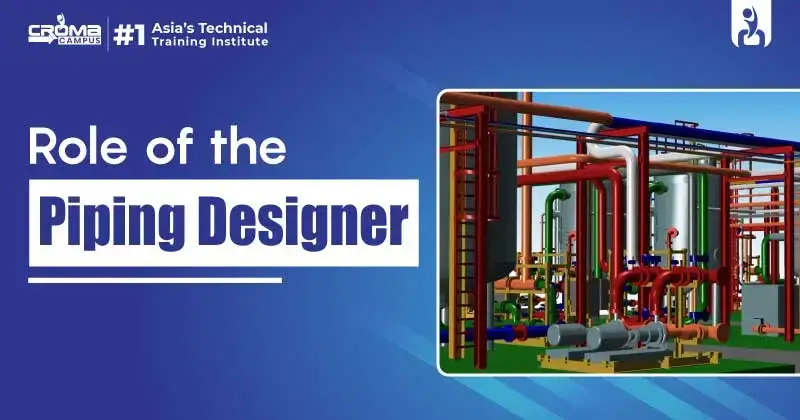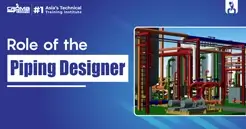What Is The Role Of The Piping Designer?
4.75 out of 5 based on 2215 votesLast updated on 9th Feb 2023 4.1K Views
- Bookmark

Piping design is a critical aspect of various industries that's why these industries need an expert Piping Designer. To know more about its role, read this post.

Piping design refers to the process of creating technical drawings, specifications, and plans for the construction of piping systems used in various industries, including oil and gas, water treatment, and chemical processing. It involves the selection of the correct materials, sizing, and routing of pipes, and the selection of appropriate valves, pumps, and other components to ensure the safe and efficient transport of fluids or gases. The final design must also consider various technical, regulatory, and economic factors, such as pressure and temperature requirements, local codes and standards, and construction and maintenance costs.
Features of Piping Designing
The main features of the piping design include:
- Selection of materials: The choice of piping materials is based on factors such as the type of fluid or gas being transported, temperature and pressure requirements, and the chemical compatibility of the material with the fluid or gas.
- Sizing and routing: The pipes must be sized and routed in a way that ensures proper flow and prevents blockages, while also taking into account space limitations and accessibility for maintenance.
- Component selection: The designer must select appropriate valves, pumps, and other components to ensure the safe and efficient transport of fluids or gases.
- Stress analysis: Piping systems are subject to various types of stresses, such as thermal, hydraulic, and seismic, and it is essential to perform stress analysis to ensure that the piping system is robust and safe.
- Compliance with codes and standards: The design must comply with local codes and standards, such as ASME B31.3 for piping in the process industry, to ensure safety and reliability.
- Economic considerations: The design must be economically viable, taking into account construction and maintenance costs, as well as the cost of any potential downtime in the event of a failure.
- Flexibility and adaptability: The design must allow for future expansion and changes in the process or fluid being transported.
- Ease of maintenance: The design must ensure that the piping system is easily accessible for maintenance and repair.
You May Also Read This Post: Is Piping Designing A Worth Learning Course
Piping Designing helps in improving safety and ensuring the safe and efficient transport of fluids or gases, reducing the risk of leaks, spills, and other safety hazards. In addition, it increases efficiency and results in improving the flow, and reduces energy costs. Piping Design ensures cost savings and helps in reducing construction and maintenance costs. It helps in minimizing downtime in the event of a failure and is designed in accordance with local codes and standards. To further know about it, one can visit Piping Design Online Training. Apart from these, given below are some of the benefits of Piping Designing.
- Better system performance: A well-designed piping system can improve the performance and reliability of the process, reducing the risk of downtime and ensuring smooth operation.
- Improved sustainability: The selection of appropriate materials and components can help to reduce the environmental impact of the piping system and improve sustainability.
- Ease of maintenance: A well-designed piping system can be easily accessed for maintenance and repair, reducing the time and cost of maintenance.
- Future adaptability: A flexible and adaptable piping design can accommodate future changes in the process or fluid being transported, reducing the cost of future upgrades or modifications.
What is the role of the piping designer?
Piping Designers have to review project requirements, including the type of fluid or gas being transported, pressure and temperature requirements, and local codes and standards. They are responsible for selecting the appropriate materials for the piping system, taking into account factors such as the chemical compatibility of the material with the fluid or gas and the temperature and pressure requirements. There are many Piping Design Training Institute in Delhi and one can enroll in them to start a career in it. Given below are some of the roles and responsibilities of a piping designer.
- Sizing and routing pipes: The designer sizes and routes the pipes to ensure proper flow and prevent blockages, while also taking into account space limitations and accessibility for maintenance.
- Selecting components: The designer selects appropriate valves, pumps, and other components to ensure the safe and efficient transport of fluids or gases.
- Performing stress analysis: The designer performs stress analysis to ensure that the piping system is robust and safe, taking into account various types of stresses such as thermal, hydraulic, and seismic.
- Checking compliance with codes and standards: The designer ensures that the design complies with local codes and standards, such as ASME B31.3 for piping in the process industry.
- Considering economic factors: The designer considers economic factors, such as construction and maintenance costs, as well as the cost of potential downtime in the event of a failure.
- Creating technical drawings and specifications: The designer creates technical drawings and specifications for the construction of the piping system, including plans for installation and maintenance.
- Coordinating with other stakeholders: The designer coordinates with other stakeholders, including engineers, construction personnel, and suppliers, to ensure the successful completion of the piping design project.
You May Also Read This: Piping Design Engineer
Conclusion
In conclusion, piping design is a critical aspect of various industries, including oil and gas, water treatment, and chemical processing. It involves the creation of technical drawings, specifications, and plans for the construction of piping systems that transport fluids or gases safely and efficiently. A piping designer plays a crucial role in this process, ensuring that the piping system is designed in accordance with local codes and standards, is economically viable, and meets the requirements of the process. The benefits of a well-designed piping system include improved safety, increased efficiency, and cost savings.
Subscribe For Free Demo
Free Demo for Corporate & Online Trainings.
Your email address will not be published. Required fields are marked *


.webp)


















 Master in Cloud Computing Training
Master in Cloud Computing Training